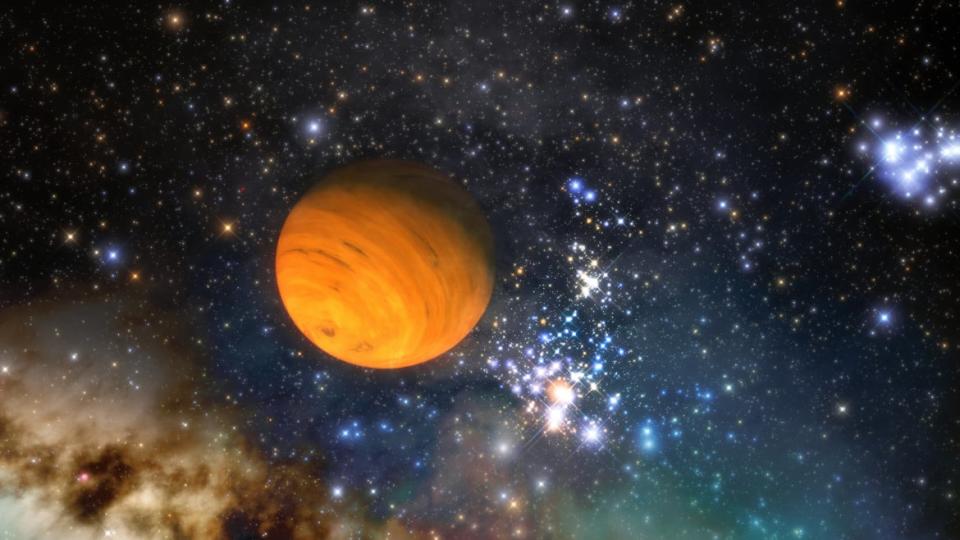We’re About to Find a Treasure Trove of Rogue Alien Planets

Brightly lit planets orbiting around blazing suns, with asteroids sprinkled between them and a few comets passing by—that’s the popular conception of how our galaxy looks. Stars are the main characters in the story of the universe, and everything else is just part of the supporting cast.
It’s also wrong. In the vast, dark, cold distances between stars, there are planets that apparently broke free of their host star’s gravity, or lingered on as brown dwarf stars after misfiring in their own attempts to become stars. These “rogue” bodies float freely in the void—uncounted, unscrutinized and, in most cases, unseen.
“Free-floating planets are literally wanderers among the stars of the Milky Way,” Alexander Scholz, an astronomer at the University of St. Andrews in Scotland, told The Daily Beast.
Rogue planets and brown dwarf stars together represent one of the big mysteries in modern astronomy. Scientists finally have a chance to begin solving, largely thanks to one fancy new instrument: NASA’s new James Webb Space Telescope. But truly settling the mystery of rogue planets and brown dwarfs might require even better technology.
The Hubble Space Telescope May Have Spotted a Free-Floating Black Hole
Taking turns with the JWST, astronomers have begun a yearlong effort that could finally constrain the population of FFPs and brown dwarfs—that is, determine the likely minimum and maximum numbers of these free-ranging objects in the galaxy.
It’s a big first step toward understanding exactly how and why these strange planets and misfired stars may have been ejected out into the vast space between star systems—and what separates them from the planets and stars that didn’t get ejected, like in our own solar system. Perhaps the set of circumstances that prevented Earth from becoming a free-floating vagabond are actually razor-thin.
The $10-billion JWST with its powerful infrared sensor is the key. “These objects are very faint, and they emit most of their light in the infrared, so a large infrared telescope with a powerful instrument is exactly what you need,” Scholz explained.
Scholz and some colleagues authored a peer-reviewed study on the ongoing rogue-planet surveys that’s set to be published in Publications of the Astronomical Society of the Pacific. (A pre-print of the study appeared online on Sept. 26.)
Before the new space telescope was available, astronomers were stuck searching for rogue planets and brown dwarfs using older space telescopes as well as telescopes on the ground—both of which have major limitations. They don’t see as far or as clearly as the JWST.
The older telescopes’ lack of higher fidelity forced astronomers to try some pretty imprecise methods for spotting rogue planets and brown dwarfs. One of these techniques is called “lensing”: An object in space lenses when it captures, and amplifies, the light from a very faraway source, like another galaxy, for example. Spotting instances of lensing can lead to the ID of rogue planets.
But with the JWST, we can simply scan the space between star systems and directly identify free-floating planets and brown dwarfs. No need to utilize work-around methods like lensing. “JWST is a fantastic machine,” Scholz said.
There are four JWST surveys on NASA’s schedule that are looking for rogue planets and brown dwarfs. The first started in August. Another began in September. Two are slated for 2023. Each aims to inspect a single star cluster, all of which are between 900 and 1,200 light-years from Earth.
The Surprising Search for the Milky Way’s ‘Lost Children’
Simulations of various star systems and clusters allowed Scholz and his colleagues to start guessing at the total population of brown dwarfs in a given region of space. The minimum, he said, should be one free-floating planet or brown dwarf for every 100 stars in a given cluster.
But a higher minimum of five rogue planets and brown dwarfs per star is possible, too, Scholz added. For context, a small cluster might have just a few hundred stars. A big one might have thousands.
This is just a rough, theoretical estimate that the JWST surveys could either confirm, or totally contradict. Scholz stressed that the population of free-floating planets and brown dwarfs could turn out to be much higher as surveys inspect more and more star clusters—in particular, older clusters.
After all, rogue planets become rogue planets when they tear free from their stars owing to complex gravitational interactions over time. By the same token, brown dwarfs are stars whose cores falter and cool after potentially millions of years. The older a star cluster is, the more rogue planets and brown dwarfs it’s likely to produce.
By counting rogue planets and brown dwarfs, we can begin painting a better picture of how star systems form—how young stars coalesce from clouds of gas, how these stars gather dust and rocks, how the dust and rocks clump together to make planets, which planets should manage to cling to each other and the star and which are likely to get rejected and flung out into the void.
“Free-floating planets are the results of the dynamic birth of planetary systems, and also of disruptions to planetary systems later on,” Scholz said. “In that sense, they are important for understanding both the formation and the long-term stability of planetary systems.”
As we locate and count rogue planets and brown dwarfs, there’s potential for some truly bizarre discoveries. Ones that could upend astronomy as we know it.
We might discover that some free-floating planets never actually belonged to any star system. According to Iain McDonald, an astronomer at the University of Manchester in the U.K., there’s a chance rogue planets could form on their own, from debris scattered across the cold void far from any star. That would be a profound exception to our current understanding of where planets come from.

Artist’s illustration of a free-floating planet.
Free-floating planets and brown dwarfs could also rewrite the history of life. That is, the story behind the evolution of living things on the only planet known to support them. Our own.
Earth is a stable planet in a stable star system—likely prerequisites for the evolution of life. It’s possible we haven’t found life in other systems because many systems aren’t stable. Free-floating planets, violently ejected from their orbits around the stars of their birth, could be evidence of—or the cause of—that instability.
“Understanding why we so far appear to be alone in the universe means understanding the planetary systems that have failed,” McDonald said. Maybe, just maybe, rogue planets are the life-killers.
It won’t be long before these first four JWST surveys wrap up and scientists can start analyzing the data and publishing their findings. The next step—a close inspection of a nearby free-floating planet or brown dwarf—could come next, eventually.
This Might Be One of the Best Planets to Host Alien Life
But that’ll be really hard. Rogue planets and brown dwarfs are so cold and so dark that, even with the JWST’s powerful sensor, they appear very faint. There’s “a serious limit on the amount of information we can get about them,” McDonald said. We can track their movement, narrow down the list of star systems they might have come from and make educated guesses at their geology.
Detailed surveys will have to wait for the next generation of technology. “Taking higher-resolution and higher signal-to-noise spectra is the obvious path forward,” Radosław Poleski, an astronomer at the University of Warsaw, told The Daily Beast.
There’s been some talk, within and between the leading space agencies, of developing a new probe with a near-infrared sensor that could take better pictures of free-floating planets. That probe could take a decade or more to design, build and deploy, assuming one space agency or another makes it a priority.
JWST allows us, for the first time, to search the void between stars for the strange objects that inhabit that space. But really getting to know those cold, dark, lonely objects—rogue planets and fizzled stars—is a job for the telescopes, and astronomers, of the future.
Get the Daily Beast's biggest scoops and scandals delivered right to your inbox. Sign up now.
Stay informed and gain unlimited access to the Daily Beast's unmatched reporting. Subscribe now.

